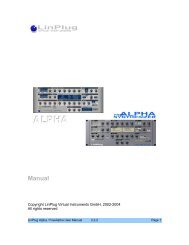User Guide - LinPlug Virtual Instruments
User Guide - LinPlug Virtual Instruments
User Guide - LinPlug Virtual Instruments
You also want an ePaper? Increase the reach of your titles
YUMPU automatically turns print PDFs into web optimized ePapers that Google loves.
StructureAudio signals are generated by the drawbars using the pitch information from daOrgan'sMIDI input. The MIDI input is automatically connected to MIDI output of your hostsoftware. daOrgan receives MIDI messages on all channels simultaneously.The output of the drawbars is sent to the Vibrato section. The output of the Vibrato sectionis then sent to the Amplifier (Drive) section. The Percussion section and the KeyClicksection both send their output to the Amplifier (Drive) section. The output of the Amplifier(Drive) section is then sent to the Rotary Speaker section. Motor Noise is added to theoutput in the Rotary Speaker section.The audio outputs of daOrgan are automatically connected to the inputs of your hostsoftware's mixer. Here you can set the pan position of daOrgan's output.The design of daOrgan imitates that of a real drawbar organ. As a result, when notes in ahigher keyboard range are played, the overall sound becomes less bright. This is becausea drawbar organ utilizes a limited range of harmonics, which wrap around at particularpoints in the instrument's upper range.Hopefully, this chapter has given you a brief overview of how daOrgan works. Moredetailed information can be found in the following chapters.<strong>LinPlug</strong> daOrgan <strong>User</strong> <strong>Guide</strong> 6












